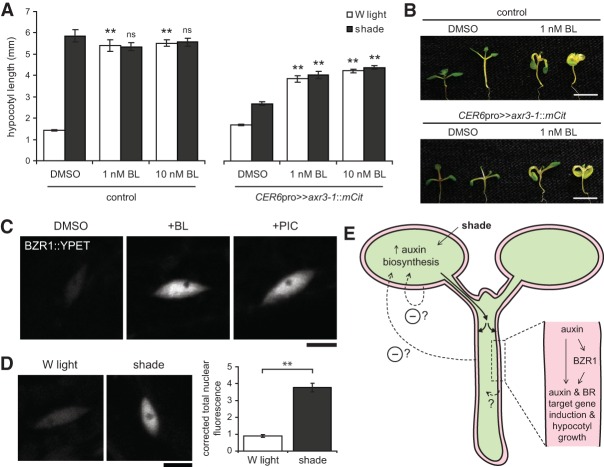Figure 7.
Auxin functions to regulate hypocotyl growth in part through the BR pathway, upstream of BZR1. (A) Hypocotyl length of 9-d-old Arabidopsis seedlings treated with white (W) light or shade in the presence of BL or without BL (DMSO vehicle). Data show mean ± SEM. Statistical comparisons are shown for each mean compared with the control genotype grown in the same light condition. (**) P < 0.005; (ns) not significant, Tukey's HSD. The CER6pro>>axr3-1::mCit line shown is number 4. Control plants were CER6pro::GAL4::VP16 hemizygotes. (B) Representative images of plants from A. For each genotype and pharmacological treatment, white light-grown is at the left, and shade-treated is at the right. Bars, 5 mm. (C,D) Representative fluorescence images of nuclear BZR1::YPET protein in hypocotyl epidermal cells of 5-d-old white light-grown plants treated for 24 h with DMSO, 1 µM BL, or 5 µM picloram (PIC) (C), or, in a separate experiment, 6-d-old white light-grown plants treated with 24 h of white light or shade (D). Images were taken near the center of the hypocotyl and with the same exposure in a given panel. Bars, 10 µm. The graph shows the corrected total nuclear fluorescence for plants treated as in D. Nuclear fluorescence was measured from 54 and 59 nuclei from 12 white light-treated and 12 shade-treated plants, respectively. Data show mean ± SEM. (**) P < 0.005, Student's t-test. (E) A model for auxin-induced hypocotyl growth in shade. Shade stimulates auxin production in the cotyledons, which is transported to the hypocotyl (Tao et al. 2008). As auxin travels down the hypocotyl via the vasculature, it is transported laterally and is perceived by the different cell layers (Keuskamp et al. 2010). Auxin perception by nonepidermal cell types has minor contributions to hypocotyl elongation but may have greater roles to play in other auxin-dependent phenotypes not assessed here. In the epidermis (red), auxin induces auxin and BR target genes and cellular growth through both BR-dependent (upstream of BZR1) and BR-independent mechanisms. How the epidermis signals back to instruct the inner cell layers on how to grow is unknown but may involve a chemical or mechanical signal. In addition, auxin signaling in the epidermis negatively feeds back onto auxin production. We were not able to resolve whether this feedback occurs in the cotyledons, from the hypocotyl, or from another organ.

